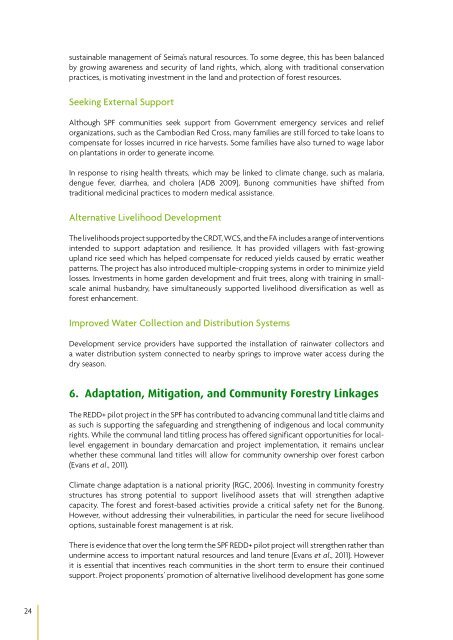Adaptation case studies.pdf - RECOFTC
Adaptation case studies.pdf - RECOFTC
Adaptation case studies.pdf - RECOFTC
You also want an ePaper? Increase the reach of your titles
YUMPU automatically turns print PDFs into web optimized ePapers that Google loves.
sustainable management of Seima’s natural resources. To some degree, this has been balancedby growing awareness and security of land rights, which, along with traditional conservationpractices, is motivating investment in the land and protection of forest resources.Seeking External SupportAlthough SPF communities seek support from Government emergency services and relieforganizations, such as the Cambodian Red Cross, many families are still forced to take loans tocompensate for losses incurred in rice harvests. Some families have also turned to wage laboron plantations in order to generate income.In response to rising health threats, which may be linked to climate change, such as malaria,dengue fever, diarrhea, and cholera (ADB 2009), Bunong communities have shifted fromtraditional medicinal practices to modern medical assistance.Alternative Livelihood DevelopmentThe livelihoods project supported by the CRDT, WCS, and the FA includes a range of interventionsintended to support adaptation and resilience. It has provided villagers with fast-growingupland rice seed which has helped compensate for reduced yields caused by erratic weatherpatterns. The project has also introduced multiple-cropping systems in order to minimize yieldlosses. Investments in home garden development and fruit trees, along with training in smallscaleanimal husbandry, have simultaneously supported livelihood diversification as well asforest enhancement.Improved Water Collection and Distribution SystemsDevelopment service providers have supported the installation of rainwater collectors anda water distribution system connected to nearby springs to improve water access during thedry season.6. <strong>Adaptation</strong>, Mitigation, and Community Forestry LinkagesThe REDD+ pilot project in the SPF has contributed to advancing communal land title claims andas such is supporting the safeguarding and strengthening of indigenous and local communityrights. While the communal land titling process has offered significant opportunities for locallevelengagement in boundary demarcation and project implementation, it remains unclearwhether these communal land titles will allow for community ownership over forest carbon(Evans et al., 2011).Climate change adaptation is a national priority (RGC, 2006). Investing in community forestrystructures has strong potential to support livelihood assets that will strengthen adaptivecapacity. The forest and forest-based activities provide a critical safety net for the Bunong.However, without addressing their vulnerabilities, in particular the need for secure livelihoodoptions, sustainable forest management is at risk.There is evidence that over the long term the SPF REDD+ pilot project will strengthen rather thanundermine access to important natural resources and land tenure (Evans et al., 2011). Howeverit is essential that incentives reach communities in the short term to ensure their continuedsupport. Project proponents’ promotion of alternative livelihood development has gone some24
















